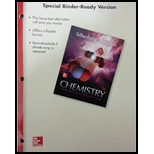
Interpretation:
Among the given experiments the one that has valid mechanism has to be predicted.
Concept introduction:
Rate law or rate equation: The relationship between the reactant concentrations and reaction rate is expressed by an equation.
Order of a reaction: The order of a reaction with respect to a particular reactant is the exponent of its concentration term in the rate law expression, and the overall reaction order is the sum of the exponents on all concentration terms.
Rate constant, k: It is a proportionality constant that relates rate and concentration at a given temperature.
Explanation of Solution
Reason for the correct option:
Experiment (2):
The given reaction involves multiple mechanism steps, by adding the entire individual steps gives rise to an overall reaction equation. Hence, the reaction equation as follows,
The overall equation becomes,
In the reaction, the slow step is the rate determining step; and its rate law is the overall rate law.
Therefore, the rate law of the slow step is,
Hence, the correct option is (II).
Reason for in-correct options:
- Experiment (1):
The given reaction is one-step collision, hence the reaction equation becomes,
The given actual rate law, is
- Experiment (3):
The given reaction involves multiple mechanism steps, by adding the entire individual steps gives rise to an overall reaction equation. Hence, the reaction equation as follows,
The overall equation becomes,
In the reaction, the slow step is the rate determining step; and its rate law is the overall rate law.
Therefore, the rate law of the slow step is,
- Experiment (4):
The given reaction involves multiple mechanism steps, by adding the entire individual steps gives rise to an overall reaction equation. Hence, the reaction equation as follows,
The overall equation becomes,
In the reaction, the slow step is the rate determining step; and its rate law is the overall rate law.
Therefore, the rate law of the slow step is,
- Experiment (5):
The given reaction involves multiple mechanism steps, by adding the entire individual steps gives rise to an overall reaction equation. Hence, the reaction equation as follows,
The overall equation becomes,
In the reaction, the slow step is the rate determining step; and its rate law is the overall rate law.
Therefore, the rate law of the slow step is,
Hence, the in-correct options are (I), (III), (IV), and (V).
Want to see more full solutions like this?
Chapter 16 Solutions
Chemistry: The Molecular Nature of Matter and Change (Looseleaf)
- How to draw the mechanism for this reaction?arrow_forward> H₂C=C-CH2-CH3 B. H₂O Pt C. + H2 + H₂O H D. 16. Give the IUPAC name for each of the following: B. Cl Cl c. Cl Cl 17. Draw the line-angle formula for each of the following compounds: 1. phenol 2. 1,3-dichlorobenzene 3. 4-ethyltoluene < Previous Submit Assignment Next ▸arrow_forwardno Ai walkthroughsarrow_forward
- The answer is shown. What is the reaction mechanism to arrive at the answer?arrow_forwardno Ai walkthroughsarrow_forwardConsider the following nucleophilic substitution reaction. The compound listed above the arrow is the solvent for the reaction. If nothing is listed over the arrow, then the nucleophile is also the solvent for the reaction. Part 1 of 2 Br CH,CN + I¯ What is the correct mechanism for the reaction? Select the single best answer. @SN2 ○ SN 1 Part: 1/2 Part 2 of 2 Draw the products for the reaction. Include both the major organic product and the inorganic product. If more than one stereoisomer is possible, draw only one stereoisomer. Include stereochemistry where relevant. Click and drag to start drawing a structure. X હૈarrow_forward
- 20.33 Think-Pair-Share (a) Rank the following dienes and dienophiles in order of increasing reactivity in the Diels-Alder reaction. (i) CO₂Et (ii) COEt || CO₂Et MeO MeO (b) Draw the product that results from the most reactive diene and most reactive dienophile shown in part (a). (c) Draw a depiction of the orbital overlap involved in the pericyclic reaction that oc- curs between the diene and dienophile in part (b). (d) Is the major product formed in part (b) the endo or exo configuration? Explain your reasoning.arrow_forward20.40 The following compound undergoes an intramolecular Diels-Alder reaction to give a tricyclic product. Propose a structural formula for the product. CN heat An intramolecular Diels-Alder adductarrow_forwardWhat is the reaction mechanism for this? Can this even be done without a base?arrow_forward
 ChemistryChemistryISBN:9781305957404Author:Steven S. Zumdahl, Susan A. Zumdahl, Donald J. DeCostePublisher:Cengage Learning
ChemistryChemistryISBN:9781305957404Author:Steven S. Zumdahl, Susan A. Zumdahl, Donald J. DeCostePublisher:Cengage Learning ChemistryChemistryISBN:9781259911156Author:Raymond Chang Dr., Jason Overby ProfessorPublisher:McGraw-Hill Education
ChemistryChemistryISBN:9781259911156Author:Raymond Chang Dr., Jason Overby ProfessorPublisher:McGraw-Hill Education Principles of Instrumental AnalysisChemistryISBN:9781305577213Author:Douglas A. Skoog, F. James Holler, Stanley R. CrouchPublisher:Cengage Learning
Principles of Instrumental AnalysisChemistryISBN:9781305577213Author:Douglas A. Skoog, F. James Holler, Stanley R. CrouchPublisher:Cengage Learning Organic ChemistryChemistryISBN:9780078021558Author:Janice Gorzynski Smith Dr.Publisher:McGraw-Hill Education
Organic ChemistryChemistryISBN:9780078021558Author:Janice Gorzynski Smith Dr.Publisher:McGraw-Hill Education Chemistry: Principles and ReactionsChemistryISBN:9781305079373Author:William L. Masterton, Cecile N. HurleyPublisher:Cengage Learning
Chemistry: Principles and ReactionsChemistryISBN:9781305079373Author:William L. Masterton, Cecile N. HurleyPublisher:Cengage Learning Elementary Principles of Chemical Processes, Bind...ChemistryISBN:9781118431221Author:Richard M. Felder, Ronald W. Rousseau, Lisa G. BullardPublisher:WILEY
Elementary Principles of Chemical Processes, Bind...ChemistryISBN:9781118431221Author:Richard M. Felder, Ronald W. Rousseau, Lisa G. BullardPublisher:WILEY





